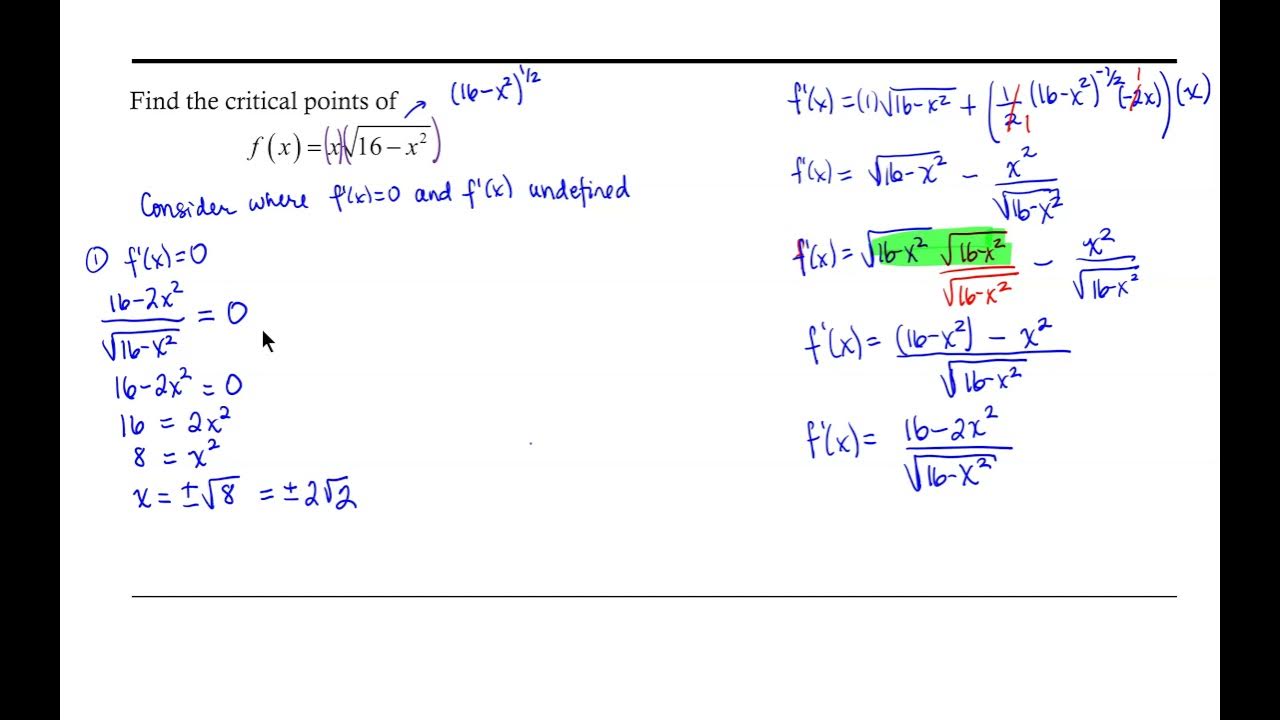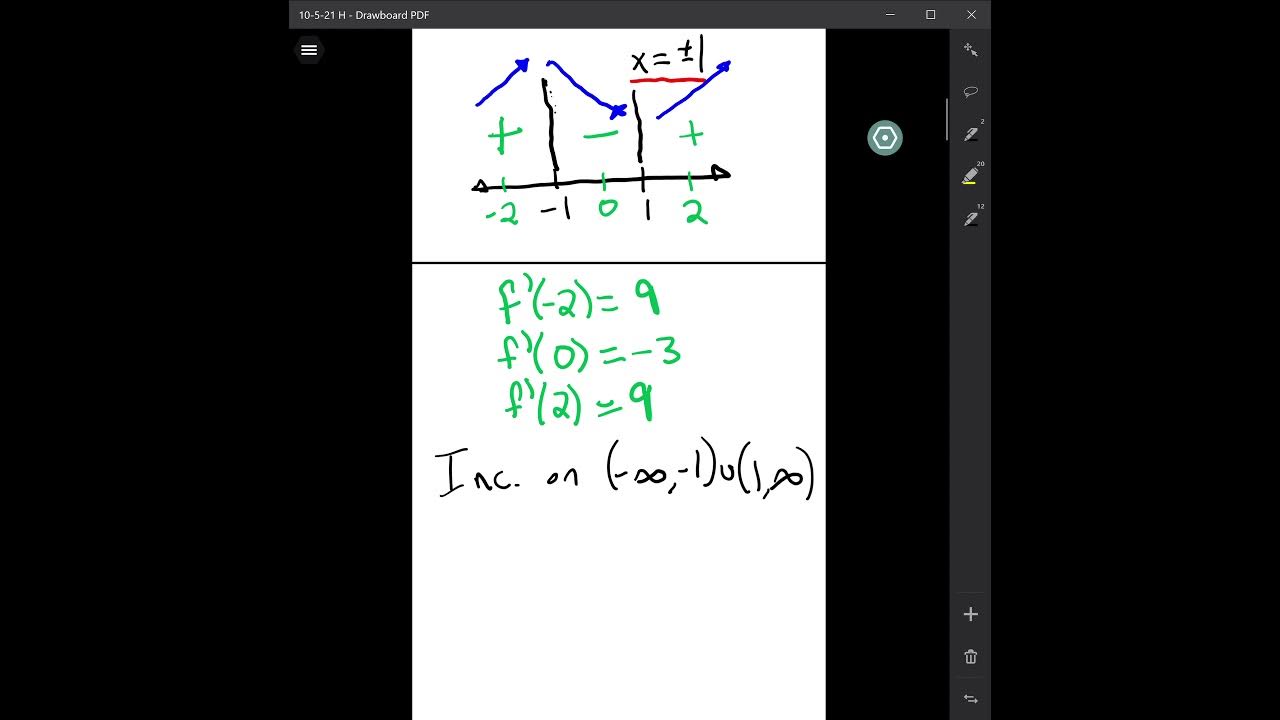Finding the Critical Points of a Function
TLDRIn this informative video, Vincent explores the process of finding critical values of a function, specifically for f(x) = x - x^(1/3). He methodically demonstrates how to calculate the first derivative and identify critical points where the derivative is zero or undefined. Through algebraic manipulation, Vincent finds that x=0 is a critical point due to an undefined derivative. Further solving leads to two additional critical points at x = ±(1/3)√3. The video effectively demystifies the concept of critical values, emphasizing their importance in understanding a function's behavior.
Takeaways
- 📚 The main topic is finding the critical values of a function, specifically for f(x) = x - ∛x.
- 🔍 To find critical points, first calculate the first derivative of the function and look for where it is zero or undefined.
- 📈 The function is written as f(x) = x - x^(1/3) to apply the power rule for differentiation.
- 🌟 The domain of the function is all real numbers, which simplifies the search for critical values within the domain.
- 🤔 The first derivative is found using the power rule: f'(x) = 1 - (1/3)x^(-2/3).
- 📝 The critical point at x=0 is found by noticing that the first derivative is undefined at this point.
- 🔢 To find other critical points, set the first derivative equal to zero and solve for x: 1 - (1/3)∛x^2 = 0.
- 🏆 Using algebraic manipulation, we find that x = ±(1/3)√(3) as the other critical points.
- 🔄 The process involves taking the reciprocal, dividing by the denominator, and raising both sides to the power to solve for x.
- 🧩 The final critical points are x = 0, x = (1/3)√(3), and x = -(1/3)√(3).
- 🎓 The video concludes by emphasizing that critical values and critical points are interchangeable terms.
Q & A
What is the main topic of the video?
-The main topic of the video is finding the critical values of a function.
What is the given function in the video?
-The given function in the video is F(x) = x - ∛x.
What is the domain of the function F(x)?
-The domain of the function F(x) is all real numbers.
How does the video suggest to find the critical points?
-The video suggests finding the critical points by taking the first derivative of the function and setting it equal to zero or finding where the first derivative doesn't exist.
What is the first derivative of F(x)?
-The first derivative of F(x) is f'(x) = 1 - (1/3)x^(-2/3).
Why is x = 0 considered a critical point?
-x = 0 is considered a critical point because the first derivative is undefined at that point, which is a case where the derivative doesn't exist.
How does the video solve for the critical points where the first derivative is zero?
-The video sets the first derivative equal to zero and simplifies the equation to solve for x, resulting in x = ±(1/3)√3.
What is the significance of finding the critical points of a function?
-Finding the critical points of a function is significant because these points can indicate local maximums, local minimums, or points of inflection, which are important for understanding the behavior of the function.
How does the video handle the cube root in the function and its derivative?
-The video handles the cube root by writing the function in a form that allows the use of the power rule for differentiation. It then simplifies the expressions involving the cube root through algebraic manipulations.
What is the final result for the critical points found in the video?
-The final result for the critical points found in the video are x = 0, and x = ±(1/3)√3.
How does the video conclude?
-The video concludes by summarizing the process of finding the critical points and expressing hope that the explanation was helpful for the viewers.
Outlines
📚 Introduction to Finding Critical Points
This paragraph introduces the concept of finding critical points of a function. The speaker, Vincent, explains that critical points are where the first derivative of a function is either zero or undefined. He sets the stage for the problem by defining the function f(x) as x minus the cube root of x and emphasizes that the domain of this function is all real numbers. Vincent outlines the process of finding critical points by taking the first derivative and identifying where it is zero or doesn't exist.
Mindmap
Keywords
💡Critical Values
💡First Derivative
💡Power Rule
💡Cube Root
💡Domain
💡Undefined
💡Reciprocal
💡Algebraic Manipulation
💡Square Root
💡Inflection Points
💡Local Maximum/Minimum
Highlights
The main topic is finding the critical values of a function, specifically for f(x) = x minus the cube root of x.
The process begins by finding the first derivative of the function to identify critical points.
The function is written as f(x) = x - x^(1/3) to apply the power rule for differentiation.
The domain of the function is all real numbers, which simplifies the search for critical values within the domain.
The first derivative is calculated as 1 - (1/3)x^(-2/3) using the power rule.
A critical value is found at x = 0, where the first derivative does not exist, resulting in an undefined expression.
To find other critical points, set the first derivative equal to zero and solve for x.
Solving the equation 1 - (1/3)x^(2/3) = 0 leads to x = ±(1/3)√3, which are the critical values.
The video provides a step-by-step guide on finding critical values, which is essential for understanding the behavior of functions.
The method demonstrated is applicable to a wide range of functions, not just the one discussed in the video.
The video emphasizes the importance of checking for points where the derivative does not exist, which is a common oversight.
The algebraic manipulations involved in solving for critical values are clearly explained, making the process accessible to learners.
The video concludes by summarizing the critical points found, reinforcing the main points of the lesson.
The presenter's approach is engaging and informative, making complex mathematical concepts easier to understand.
The video is a helpful resource for anyone looking to improve their understanding of calculus and critical values.
The critical values are x = 0, and x = ±(1/3)√3, which are the points where the function's behavior changes.
The video's content is structured logically, starting with the definition of critical points and moving towards their calculation.
The video is an excellent example of educational content that breaks down complex topics into manageable parts.
Transcripts
Browse More Related Video

Finding Critical Values

Analyzing a function with its derivative | AP Calculus AB | Khan Academy

Absolute Maximum and Minimum Values - Finding absolute MAX & MIN of Functions - Calculus

Critical Points: Square Root Function

Relative Maxima/Minima Examples

Fiding Relative Max, Min and Inflection Point with Derivatives F4
5.0 / 5 (0 votes)
Thanks for rating: